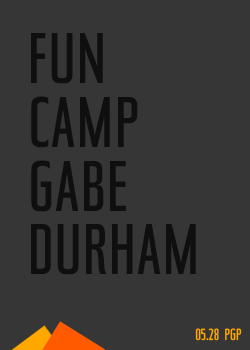What do I do with my memories, my longings, my hurts, the things unresolved between us?
A Review of A Questionable Shape, by Bennett Sims (Two Dollar Radio, 2013)
 The first zombie in Bennett Sims’s A Questionable Shape doesn’t appear until page 161, and then only as a silhouette seen from across a lake. Most of the zombies have been detained, quarantined, or “put down” by a government that seems relatively more functional in its performance of disaster relief, especially in Louisiana, than in its earlier iteration, not so long ago, in the aftermath of Hurricane Katrina. The undead that remain roaming the bayou possess “roughly the same citizen status and legal rights, as, say, coma patients or the mentally ill.” FEMA funds refugee shelters and welfare checks and undead search operations, although, by now, the term “undead” is increasingly frowned upon for being “dysphemistic and dehumanizing.”
The first zombie in Bennett Sims’s A Questionable Shape doesn’t appear until page 161, and then only as a silhouette seen from across a lake. Most of the zombies have been detained, quarantined, or “put down” by a government that seems relatively more functional in its performance of disaster relief, especially in Louisiana, than in its earlier iteration, not so long ago, in the aftermath of Hurricane Katrina. The undead that remain roaming the bayou possess “roughly the same citizen status and legal rights, as, say, coma patients or the mentally ill.” FEMA funds refugee shelters and welfare checks and undead search operations, although, by now, the term “undead” is increasingly frowned upon for being “dysphemistic and dehumanizing.”
The search for the undead yet at-large in Louisiana has grown quite urgent by the novel’s beginning, because in five days it will be the end of July, and the beginning of hurricane season. The story’s narrator, a young bookish man named Vermaelen, has agreed to help his friend Matt Mazoch search for his undead father.
The five days they have left in their search–Monday through Friday–serve double- READ MORE >
Hello Poetry Lovers
“Hello Poetry Lovers”
from Quinta Essentia Vol. 0 written and read by Blaster Al Ackerman
video by Cristine Brache (using stock and found footage)
for the O, Miami Poetry Festival 2013
I STILL DON’T “GET” POETRY READINGS

A few weeks ago, I gave poetry readings a hard time on HTMLGIANT. When I wrote the article, I was aware of its potential to generate conversation. However, I had no idea just how much conversation it would generate.
To everyone who participated in the conversation, thank you. I can’t say that I liked everything that everyone had to say (just as many of you didn’t like what I had to say), but that’s okay. Everyone’s allowed an opinion. In fact, as creatures of language, it’s impossible for us not to have opinions because language relies on difference in order to make meaning; or at least that’s what I think Derrida would say. It’s only sensible then that our opinions (not just yours and mine on this particular matter but everyone’s opinion on anything/everything) should often differ.
To get to why I’ve titled this article “I Still Don’t ‘Get’ Poetry Readings,” though, I’ll tell you it’s because I don’t. I don’t “get” poetry readings. I don’t “get” them not for a lack of trying. I don’t “get” them because I don’t understand what readings hope to achieve within the broader framework of culture. I’ve been to many poetry readings, some of which have moved me so deeply that I cried (Tomaž Šalamun) and some of which have failed to reach me (though also not for a lack of trying). Despite how very different poetry readings can be from one another, I’ve noticed that they all share the same quality of autonomy. It seems to me that the poetry reading desires to be a space that exists for itself and through itself. My complaint, however, isn’t with the poetry reading’s desire for autonomy but rather with the inaccessibility this desire creates.
In my last article, the solution I was pushing for was to make poetry readings more “accessible,” more transparent. Here, I’m pushing for the same idea. Accessibility is what defines the Electronic Age in which we live. Accessibility is about mass consumption, and mass consumption is about power.
In this essay, as well as in the last, I’m urging poetry readings to actualize their full potential: to realize their power.
I’ve read through all the responses to my first article on both HTMLGIANT and Facebook (no, I’m not friends with Hoa Nguyen, but her wall is public), and I strongly feel that my last essay was deeply misunderstood. To clarify the position of my last essay, I’ll respond to a few of the responses that point to its underpinnings.
I think the response that best contextualizes my first article and the meaning I intended it to summon forth is this one:
The Nation Versus The Norton Postmodern Anthology Disaster (2nd Edition)
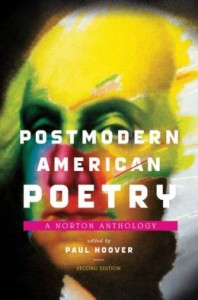
RE: Postmodern American Poetry: A Norton Anthology (2nd Edition) / Edited by Paul Hoover / W.W. Norton & Co., March 2013
***
Anthologies serve a plainly economic purpose, if nothing else. Pedagogical too…most teachers and students of poetry—along with its general lovers everywhere—lack the time and/or wherewithal to go out and find so many individual titles on their own. This new Norton edition via Paul Hoover, generously upgraded since the first in 1994, writes Conceptual and Flarf poetry into a Postmodern American narrative that has become desperate for extensions. None of the poets here come off as desperate; the blanket labeling is merely academic. Once outside the classroom it feels very old-hat. But as poet and critic Ange Mlinko pointed out in her already notorious review of this book for The Nation, under what other aesthetic banner can a major publisher have the Zen nature verses of Gary Snyder together with K. Silem Mohammad’s rewritings of Shakespeare via an internet anagram generator?
It’s only been a couple of months since the anthology came out, and already there is a scandal in the works. Poets dig war. The politics/poetics of who gets left in, and who gets taken out, or who gets tacked on to the end remains an uninteresting mystery. Pop outliers like Charles Bukowski have been left out this time around, but the more high-profile writers of the Beat Generation, New York School 1st & 2nd generation(s), Black Mountain Poets and Language School are all given their due throughout these pages, once again. If you don’t know what any of those are, this book will no doubt be indispensable to you. Now the same goes for Conceptualism and Flarf. Flarf has never had its own private anthology (maybe on purpose?) while Conceptualism decidedly has, with Against Expression: An Anthology of Conceptual Writing just two years ago. Nevertheless, of all the poetry groupings/movements in this book, these two are still the most involved in the business of constantly redefining themselves before a potential public.
Femme et al.

Pepé Le Pew was a French skunk (Looney Tunes, Warner Bros., 1945) who falls in love with a black cat whose backside and tail are accidentally painted white from a spilled bucket of paint. Thinking the cat is a skunk, “la belle femme skunk fatale,” Pepé courts her with obtuse conviction, the unwitting cat too docile to even meow. I’ve always found this cartoon bleaker than the rest, its lonely protagonist even more deluded than shotgun brandishing Elmer Fudd. Many earlier cartoons operate as grim allegories about futile pursuit (i.e. Woody Woodpecker, Tom and Jerry, etc.), as if already apologizing for adulthood. The false white stripe, then, may represent steadfast projection, however ingrown. This has little to do with Susan Sontag, other than, inversely, her admitting to dying her hair black once it went grey, save the streak of white for which she was known. Caused by Waardenburg syndrome — a rare genetic disorder characterized by pigmentation anomalies in minor cases, and deafness in more acute ones — the white streak became a signature of premature maturity, wisps that hinted, or rather could not contain, great wisdom. I use “admitted” in parallel to “disclosing,” which were Carl Edmund Rollyson and Lisa Olson Paddock’s word in Susan Sontag: The Making of an Icon (2000), as the implication is that the dyeing of one’s hair falls into the camp of cosmetic vanity, that she should have just “greyed out” the old fashioned way, to let the formidable stripe become unnoticeable with age. She is to die of cancer in 2004, which cynically brings to mind a statement of hers in the Paris Review (1967) that “the white race is the cancer of human history,” whose subsequently brilliant sarcastic recantation was that “it slandered cancer patients.” A great writer always wins on paper; as for real life, the loss is immeasurable. It’s endearing how bad white people feel, how you’ve turned your neutral description into a pejorative. I’ve decided to love her, regardless of her hair, on my behalf. It’s easier this way. If life is a game of leaving quotes behind, the dead always win. Now all of us have something to look forward to.
On Adoration

It is odd how someone so sly online can be so shy in real life. That the former must compensate for the latter is something many of us may relate to. As Amanda Bynes slowly goes insane, we have a new disaster to follow, eyeing the eye of the hurricane from the safe distance of a meteorologist in front of a green screen. I hadn’t even heard of her until some of her witty, curious, but ultimately desperate tweets (wanting Drake to “murder [her] vagina”; calling other female celebrities “ugly”; posting increasingly explicit selfies). I imagine a small stake through her cheek piercings, like shish-kebab, disrupting the flow of her tongue. As standard news outlets address this as “bizarre behavior” and “cries for help,” we enjoy the heightened narrative of non-fiction, though Bynes is as much a masterful creation as Madame Bovary herself. In what has now become #bynesing, Amanda shields her face in modesty, or horror, an eerie nod to the Islamic Burqa (or Niqāb, with a slit) featuring a little window through which women, in public and/or in front of adult males, can navigate their world with truncated periphery. This requirement, called “Hijab,” unsurprisingly stems from the Qur’an, a place of deep sexual paranoia, or subverted fantasies, regarding incest. It’s a mess, but basically, the hood somehow keeps slutty daughters from fucking their fathers or brothers. As one-fourth of the world’s population prays at five appointed times a day towards Mecca, it’s hard not to see such circadian devotion as a kind of ultimate militia come the apocalypse, whose semi-finals will likely be between Allah, Jesus, China, and Walmart.
fun camp blooper negation
Seven days ago HTMLGIANT received an anonymous review submission for Fun Camp by Gabe Durham. An anonymous review went live today around noon. However, the review had to be taken down today a little after five. Sometimes you get an email at 8:04 AM and then another at 8:08 AM and you just read the one from 8:04 AM and then that causes a blooper. This is perhaps irrelevant to the following:
Late work
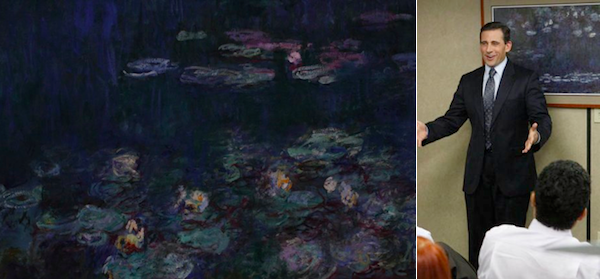
One wonders if the staff of Dunder Mifflin ever saw the late Monet waterlilies painting, a print at least, framed in the conference room as a kind of covert bourgeois window through which one might mentally escape to softer times, whose chubby mascot was a man slowly taken by cataracts, whose artistic vision was no doubt clearer than his literal one. French impressionist (and, to a degree, Pop Art and Abstract Expressionist) prints are mainly used in corporate settings to placate the employee, condescendingly, as if all they needed to be happy was something pretty to stare at, when in fact it only implicates the dissonance between surrendered office life and the more vigorous ideals of artistic inquiry. I’ve always found the late Monet print an odd, yet provocative, choice. Perhaps the set designers wanted something deep behind the shallowness of Michael Scott. As The Office plays out its final season, we may be left with some more inadvertent metaphors: the casting politics of who would play the boss, and the legacy of an unstable company, who in a realist market would have been eaten alive by more faceless competitors Office Depot and Office Max; the sweet courtship and eventual nuptials of Jim and Pam, whose subsequent boredom of each other seemed to ooze from the actors without acting; the rogue zen of Stanley Hudson, who solved 10,000 crossword puzzles in what were likely out-of-body experiences; the increasingly comical scenarios less probable, obsolete after the novelty of the ironic “fourth wall nod” wore thin. Most compelling were the accurate personnel departments (e.g. Accounting, Office Relations, Sales, Human Resources, Executive, Warehouse, Production) ascribed to each character, whose demeanor and actions held consistent with them. Such vocational intricacy had, in the past with other shows, been simply consolidated as an abstract “job” to which someone went when they weren’t on the main stage, that is, home. The Office took the family away from home, into their own personal world of laughter and resent. Monet, the more successful of the French impressionists, built Giverny garden for the sole purpose of having a final chronic subject to paint until his death; he painted around two-hundred-and-fifty waterlilies, whose muddled canvases, thick and opaque, wore the transparent mask of a lake’s surface barely there. At its best, art is the profound realization of the invisible. Imagine a half-blind man — who famously declined ophthalmological help in aid of his abstractions — squeezing out more and more purple like an inside bruise finally surfacing, each work darker and darker, as if to trace the slow yet unwavering arc of an hourhand as it approaches night.
SOME BOOKS THAT I’VE RECENTLY ACQUIRED THAT I ‘M REALLY EXCITED ABOUT.
***
The Spectral Lens & Apparition of a distance, however near it may be by Paul Soulellis
I met & discovered the work of Paul Soulellis at the recent LA Art Book Fair and got super excited right away.
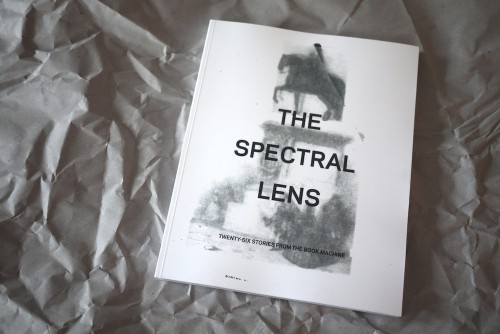

As taken from his website (as are the photos above):
The Spectral Lens (Twenty-Six Stories from the Book Machine) (2012) is a visual poem featuring images photographed by Google book scanners through tissue paper. The scanner treats the tissue paper as a “valid” page in the book and scans it as it would any page, capturing the image (or text) behind it. The images are degraded in various ways, depending on the texture and opacity of the vellum. Rips or folds in the tissue are sometimes captured.
The images are “mistakes”—visual information that might normally be corrected or removed by bots. Instead, the errors remain as permanent additions to the Google Books library, forever altering the viewer’s perception of the work.
I search for these mistakes and treat them as found photography. My screencaptures expose deviations in the algorithms hiding deep within the archive.
The Spectral Lens is at once the glass eye of the book machine and its faceless human operator; it is also the lens-less “camera” of my computer.
I was immediately struck by the haunting simplicity of these images, that such a strange and technological process could aid in creating such immediate & subtle emotional works.
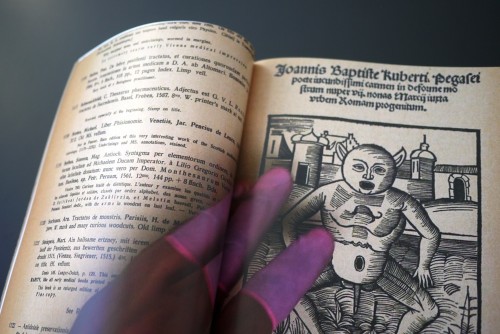
His other project, though similar in technological source looks at a different sort of glitch. Also from his website:
Apparition of a distance, however near it may be (2013) is a collection of found images portraying Google Books employees physically interacting with books inside the digital space of the book scanner, gathered into a 42-page print-on-demand publication.
As accidental recordings, the images mistakenly add human physicality, movement and distortion to the experience of consuming the static book in a browser window. These anomalies are usually corrected or removed by bots, but sometimes the errors remain, becoming spectral additions to the Google Books library and permanently altering the viewer’s perception of the content.
Here the images aren’t haunting, but slightly unsettling and creepy. Something about the lingering, partially-gloved hand that adds a strange layer to the usually austere realm of Google Books.
April 26th, 2013 / 2:46 pm


